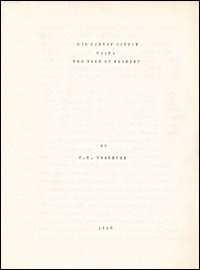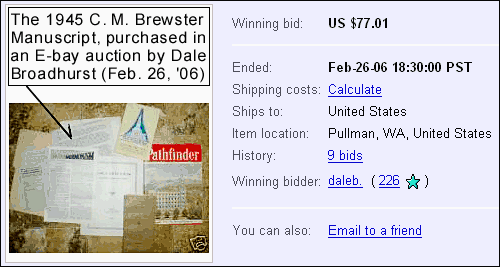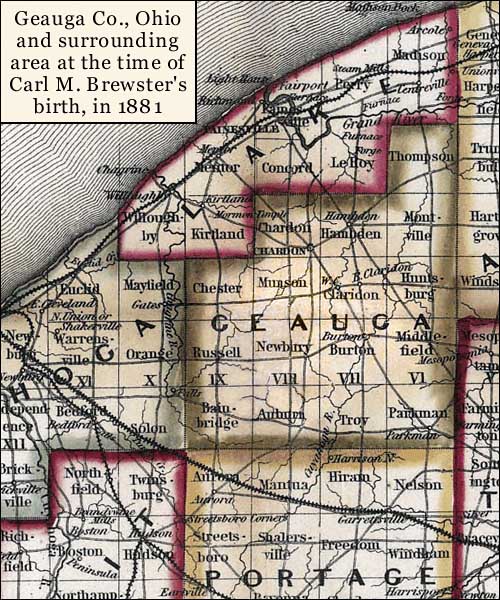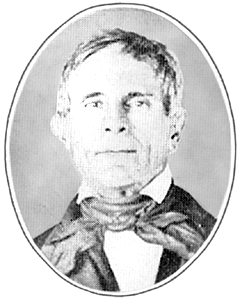
Mormon Classics | Spalding Library | Bookshelf | Newspapers | History Vault
|
Carl M. Brewster
1881-1961 "Did Sidney Rigdon write the Book of Mormon?" (unpublished manuscript, 1945) |
 (view larger cover page image)
(view larger cover page image)
|
Eight Brewster Cousins (1937) | C. M. Brewster papers (WA) | Sidney Rigdon at Bainbridge
|
DID SIDNEY RIGDON WRITE THE BOOK OF MORMON? BY C. M. BREWSTER 1945 |
|
[ 2 ]
There has long existed a widespread feeling among certain residents of southern Geauga County, State of Ohio, that they and their forefathers were privy to some little known facts: truths which were hidden away as a profound secret when Joseph Smith and Sidney Rigdon first established their Mormon church upon the Western Reserve of Ohio...
(pp. 2-105 not transcribed, pending |
|
A GENEALOGY OF THE EIGHT BREWSTER COUSINS OF NORTHERN OHIO AND THEIR DESCENDANTS With Space for the Continuation of the Record for Each Family By CARL M. BREWSTER State College of Washington Pullman, Washington |

Screen-capture image (made Feb. 26, 2006) showing lot of "LDS" items sold on E-bay that day. Dale R. Broadhurst's Comments Carl M. Brewster's 1945 "Rigdon" Manuscript Carl Milton Brewster was born born on May 19 1881, in Bainbridge twp. (near Chagrin Falls), Geauga Co., Ohio, the only son of Milton Foster Brewster and Mary Launspach Lambert. He attended school in northern Ohio and was one of Oberlin College's Class of 1903 B. A. graduates. For many years he taught as a professor of Organic Chemistry at Washington State University. He died in 1961 at Pullman, Washington. Carl's father, Milton Foster Brewster (1854-1937) and his grandfather, Calvin H. Brewster (1812-1867) were longstanding residents of Auburn and Bainbridge twps., Geauga Co., Ohio -- the grandfather having moved to that area from upstate New York as a young man. Among Professor Brewster's "hobbies" was the study of Mormon history, an interest that he appears to have developed while living in Washington State during the 1930s. Some of his personal papers indicate that he was encouraged in his historical studies by the Seattle minister, Rev. Claton Silas Rice (the author of several obscure publications on Mormonism, including Ambassador to the Saints, published shortly before his death in 1972). While Professor Brewster seems to have carried out most of his research into the early history of the Mormons in his maturity (during the 1930s and early 1940s), there is reason to believe that he inherited his interest in this topic from his father and other Ohio Brewsters. This family of Geauga County Brewsters were related my marriage to the Henry family of Bainbridge, Ohio and Professor Brewster is known to have been in contact with at least one member of the latter family in regard to his Mormon history studies: Frederick A. Henry, a cousin and an amateur historian of some note in northern Ohio. In order to better document Professor Carl Milton Brewster's studies along these lines, it is useful to first examine his kinship with Frederick A. Henry. Genealogical Considerations In his 1937 book, Eight Brewster Cousins, Carl Milton Brewster outlines the family tree of his father and grandfather. Briefly, his line of descent is: b. 30 Jan 1770; Lebanon, New London, CT d. 29 Jan 1844; Chardon, Geauga, OH Calvin H. Brewster (generation 2) b. 16 Jan 1812; Ellisburg, Jefferson, NY d. 17 May 1867; Auburn, Geauga, OH Milton F. Brewster (generation 3) b. 11 Jan. 11, 1854; Auburn, Geauga, OH d. 17 Aug., 1937; Chagrin Falls, Cuyahoga, OH b. 30 Jan 1770; Lebanon, New London, CT d. 29 Jan 1844; Chardon, Geauga, OH Jessie Brewster (generation 2) b. 15 Jun 1802; Rome, Onedia, NY d. 01 Oct 1863; Claridon, Geauga, OH Henry I. Brewster (generation 3) b. 26 Jan 1828; Ellisburg, Jefferson, NY m. 01 Jan 1848; Bainbridge, Geauga, OH, Martha "Ann" Henry 
Professor Brewster's Sources Professor Brewster laboriously copied on his typewriter a number of source texts which documented the events of Mormon history in Ohio, including one very special source, taken from his cousin Frederick's biography of "Captain Henry." That text first appeared as an article in the Cleveland Leader of March 14, 1886 under the heading: "Sidney Rigdon -- His Connection with the Spaulding Manuscript and Book of Mormon." There is good reason for believing that this material, from Frederick A. Henry's 1942 book, provided the stimulus for Professor Brewster's 1945 manuscript, "Did Sidney Rigdon Write the Book of Mormon?" Indeed, it is the first source that Professor Brewster reproduced and commented upon in the pages immediately following his "Preface" for that mansucript. In the rough draft of his "Sidney Rigdon" manuscript which sold on E-bay in February of 2006, Brewster supplied no proper bibliography nor listing of his sources. That manuscript is incomplete, however, and in his final draft he may have included such a tabulation. From a reading of his disjoined 1945 text, the following sources can be identified: 2. Various early histories of the Campbell-Stone Restoration movement (Campbellites), including A. S. Hayden's 1875 Early History of the Disciples... and Alanson Wilcox's 1918 A History of the Disciples of Christ in Ohio. 3. At least six biographical works: F. A. Henry's 1905 A Record of the Descendants of Simon Henry; F. A. Henry's 1942 Captain Henry of Geauga; Francis Atwater's 1901 Atwater History and Genealogy; Eliza R. Snow's 1884 Biography and Family Record of Lorenzo Snow; "Ancestry of Orrin Porter Rockwell," from the Deseret News Church Section of Aug. 31, 1935; and Professor Brewster's own 1937 A Genealogy of the Eight Brewster Cousins of Northern Ohio. 4. A large number of books dealing with Mormon history, including: Clark Braden's 1884 Braden-Kelley Debate; James H. Kennedy's 1888 Early Days of Mormonism; A. T. Schroeder's 1901 Origin of the Book of Mormon; William A. Linn's 1902 Story of the Mormons; Charles A. Skook's 1914 True Origin of The Book of Mormon; and George B. Arbaugh's 1932 Revelation in Mormonism. Professor Brewster appears to have been aware of Eber D. Howe's 1834 book Mormonism Unvailed, only by way of quotations from that work given by later authors -- the same may be said for Robert Patterson's 1882 Who Wrote the Book of Mormon. Brewster seems to have not known about Arthur B. Deming's 1888 Naked Truths About Mormonism; however he refers to Deming's 1884-85 interviewing of northern Ohio residents, such as Orrin Porter Rockwell's two married sisters. This indirect knowledge of Deming's interviews evidently reached Brewster by way of 1880s Ohio newspaper articles, as well as references in Shook's book, Rev. R. B. Neal's Sword of Laban periodicals, and Rev. John D. Nutting's 1930s magazine Light on Mormonism. Brewster carried on a correspondence with fellow Oberlin graduate Rev. Nutting and it seems that Nutting was aware of Brewster's initial research into cliams that Sidney Rigdon wrote a portion of the Book of Mormon at Bainbridge, during his 1826-27 tenure in that Geauga Co. township. Brewster would have benefitted greatly from direct access to the Deming statements, as well as to a copy of Orrin Henry, Jr.'s 1880 letter to the Portland, Oregon New Northwest. However, even without these Deming and Henry materials, Professor Brewster was able to tie together a number of family traditions, local recollections and known historical facts, and to come up with some remarkable conclusions regarding what he referred to as the "Ohio birth of Joe Smith's Mormonism." Professor Brewster's Conclusions Unfortunately the main portion of Brewster's historical discoveries are missing from the set of 1945 manuscript pages sold at the E-bay auction on February 26, 2006. From the extant pages of his report, the following findings and speculations may be outlined: 2. A number of these early pioneers were Baptists and there was at an early date a Baptist community in Auburn, that extended across the Portage Co. boundary into Mantua township. The "Reformed Baptist" preacher, Rev. Sidney Rigdon, visited among these Auburn-Mantua Baptists during the early 1820s, and then returned to live within that same community during the winter of 1825-26, at which time he took up residence in adjacent Bainbridge township (see map above). 3. In the spring of 1826, Joseph Smith, Jr., "in company with a notorious ruffian," arrived in Auburn on a temporary visit. According to Brewster, Smith and his companion arrived with a party of emigrants originating in Manchester, Ontario Co., New York. 4. During the early part of 1826, Joseph Smith, Jr. and the Rev. Sidney Rigdon met, first in Auburn and then again in neighboring Bainbridge. The two men became mutually interested in each other and Rev. Rigdon accompanied Smith to Pennsylvania, and perhaps also to Ontario Co., New York. 5. Following his return from this trip to the east, Sidney Rigdon completed a thick "religious manuscript" he had written (or re-written) during the winter of 1825-26. Upon his finishing his writing, Rev. Rigdon took a "great interest in the Baptists of Auburn... and Mantua" and "made frequent visits to... Aurora [Portage township bordering Bainbridge]... Auburn... Mantua and Hiram." [The latter is a Portage township bordering Mantua.] 6. Rigdon then moved north about 30 miles to take up new duties as the pastor of the Baptist congregation at Mentor, but he continued to visit Auburn, Mantua and Hiram on a frequent basis. He induced two members of the "Reformed Baptists" in Portage Co. (Darwin Atwater and Zeb Rudolph) to accompany him to Mentor, where these students became of Rigdon's "strange absences" from that place, as well as his supposed visits to western New York -- all prior to his conversion to Mormonism in November of 1830. Professor Brewster make two significant errors in his findings, however. At one point in his extant pages, he makes the assumption that when Joseph Smith, Jr. allegedly visited Auburn in the spring of 1826, that he was accompanied by his Manchester friend, Orrin Porter Rockwell, and that the two young men stayed in Auburn with the family of Rockwell's sister, Emily Rockwell Stafford. However, Emily did not move from Manchester, New York to Auburn, Ohio until 1831 -- so it is very unlikely that she was living in Ohio as early as 1826. Brewster's second faulty assumption was that "Rockwell, Smith and Rigdon" could have been seen together in Auburn, only "several months before the Book of Mormon was readied for the press" in Palmyra, New York. Rather than the three having been seen together by "the settlers" in Auburn, in 1826, a more likely date would have been during the year 1831. Rigdon's 1832 visit to Auburn From the middle of September, 1831 until the end of March, 1832, Mormon leaders Joseph Smith, Jr. and Sidney Rigdon lived with their families on the John Johnson farm in Hiram twp., Portage Co., Ohio. During this same period Emily Rockwell Stafford moved with her husband, Christopher M. Stafford, from Manchester to Auburn. According to Christopher's 1885 statement to Arthur B. Deming, the couple arrived in Auburn on Dec. 2, 1831. Since Smith was living but a few miles away, it is not unlikely that he soon thereafter visited with these old neighbors from his home town. In the case of Sidney Rigdon, the history is clear -- he visited Auburn in company with Elder William E. McLellin on Sunday, Jan. 15, 1832 (only six weeks after the Staffords' arrival) and spoke in a religious meeting there for "about 2 hours," (see Journals of William E. McLellin 1831-1836, p. 69). The entire population of Auburn in 1830 was but 428 residents (including the children) and in a six-mile-square township, it is not unreasonable to assume that Christopher R. Stafford and his wife Emily Rockwell Stafford were among those "settlers" attending Rigdon's preaching service. Certainly Rigdon, Smith, Rockwell and the Staffords would have enjoyed ample opportunity to have met and to have been seen together in Auburn during that same winter. Professor Brewster's assumption -- that Rigdon, Smith and Rockwell were seen together at the home of Rockwell's sister, in Auburn as early as 1826 -- is not only a highly unlikely one, it is an assumption that may have rested upon a garbled report of the three men having been seen together, at that sister's home, five or six years later. Recourse to the statement given Mr. Deming by Orrin Porter Rockwell's other Ohio sister (Caroline Rockwell Smith) is not helpful at this point either. In that 1885 affidavit Caroline admits that "My brother, Orrin Porter Rockwell, made me a visit" in Ohio, but then says that the visit occured "in 1844 or '45." Besides which, Caroline was not married to Horton Smith until Jan 7, 1834 (at Chardon?) in Geauga Co., Ohio. Prior to her marriage Caroline appears to have resided with her parents at Kirtland. The Rockwells did not arrive there until early in 1831 -- four or five years after Rigdon's alleged first meeting with Smith, in Auburn. What Really Happened? Unless some more definitive evidence can be brought forth, in support of the notion that Orrin Porter Rockwell was seen in Auburn township, Geauga County, Ohio in 1826, his name will probably have to be dropped from Professor Brewster's reconstruction of pre-Mormon history. That leaves the allegation that Joseph Smith, Jr. was seen in that same place in 1826. That is not an implausible event. Auburn was a known gathering place for pioneers coming from Smith's home town, and Smith's whereabouts for much of the year 1826 remain undocumented. Had Brewster provided some early published evidence for his assumption, it might be easier for modern students of Mormonism to take the possibility more seriously. Brewster several times cites undated articles published in the Chardon Geauga Republican, but whether or not such obscure sources can shed any light upon the question remains unknown -- and perhaps unknowable. Aside from Carl M. Brewster's 1945 assumptions, there remains the 1942 statement made by his cousin, Mr. Frederick A. Henry of Bainbridge, Ohio: Among the many Disciples of Christ, or "Campbellites," on the Western Reserve, who were attracted for a season into the Mormon fold, Sidney Rigdon stood easily first. Ambitious, erratic, and eloquent, but not over-scrupulous, he became at once the brains of Mormondom. Grandfather John Henry maintained that he probably compiled the Book of Mormon while sojourning one winter (1825-1826) in Bainbridge. In his quarters south of the Center, he seemed always to be writing, sometimes far into the night; and though he received courteously all who called, he would first lift the lid of his desk and lock his mysterious manuscript away therein before admitting them. 
"Grandfather" John Henry (1796-1869) Had Frederick A. Henry's grandfather left behind any written or published account of Sidney Rigdon's life in Bainbridge, such an historical momento would indeed be a valuable one. As it now stands, there is no known account of Methodist Class Leader John Henry's interaction with the recently defrocked Baptist parson, Sidney Rigdon, lately relocated to Bainbridge from Pittsburgh, Pennsylvania. It is not likely that relations between the two men were particularly cordial. Rigdon himself supplies a small glimpse into this obscure portion of his early religious career: [In 1826 Rev. Rigdon]... removed to Ohio as an Independent Baptist, preaching what he pleased and contradicting whomsoever he pleased. He himself stated that not unfrequently he would attend a service and take his seat among the congregation, and after the sermon arise and ask the liberty of adding a few remarks, and then quote passages of Scripture to show the erronous doctrines which the preacher had just uttered, and close by inviting the congregation to come and hear him at his next appointment. This kept the community in a ferment and secured for him crowded houses. He seemed just on the point of forming a new sect which should overthrow by learning, logic and eloquence all the creeds and religious systems of the world!! No doubt Rev. Rigdon's actions did keep "the community in ferment," all through the southwest corner of Geauga and northern section of Portage counties. In his 1945 manuscript, Professor Brewster quotes from page 143 of the 1880 Pioneer and General History of Geauga County, as follows: "Joel S. Giles came from Warsaw, New York, to Bainbridge... [his] farm [was] situated near the southwest corner of the township... [on the edge of] Geauga lake... Joel Giles, sr., and wife, were members of the Baptist church, which was organized at an early day in that part of the township. Services were held first in private houses, and later in a school-house. The church propsered for a few years, but was eventually broken up by a wolf in sheep's clothing (Sidney Rigdon, of Mormon notoriety), who entered the fold, and the sheep were scattered abroad." If Sidney Rigdon's unorthodox preaching of 1826-27 alienated many of his fellow Baptists, the modern reader can only wonder what sort of effect the man must have had upon the local Methodists and Presbyterians. No doubt Reverend Rigdon found more sympathetic audiences a few miles further east, in Auburn and Mantua. He was respected enough in the former township to be called upon to preach a funeral sermon there in May of 1822, when he was residing in Pittsburgh, but perhaps happened to then be visiting his wife's relatives in neighboring Trumbull Co., Ohio (see the 1885 Isaac Butts statement in Deming's Naked Truths newspaper). Or, perhaps Issac Butts' memory of his brother's death was off by a year, and Rigdon was called over from Trumbull Co. to preach the funeral sermon before he moved to Pittsburgh. At any rate, Sidney Rigdon appears to have been a well-known religious figure in Auburn during the 1820s. His close interactions with Auburn settlers who had come there from Palmyra and Manchester must be accepted as a solid fact -- and a fact that dates to several years prior to the publication of the Book of Mormon in the former New York town. As already stated, John Henry left behind no written nor published recollections of Sidney Rigdon, so his memories of the defrocked Baptist preacher evidently came down to cousins Frederick A. Henry and Carl M. Brewster only as oral family traditions. Frederick's father, Charles E. Henry, passed along what appears to be more substantial oral history, in his 1886 letter to the Cleveland Leader. Both Frederick and Carl make this letter the certerpiece of their respective claims for Rigdon's involvement in the creation of the Book of Mormon. Charles E. Henry's re-telling of George Wilber's 1826 experiences with Sidney Rigdon are made doubly interesting by the fact that Mr. Wilber was a long-time resident of Auburn. Wilber undoubtedly lived among and personally knew most of the Auburn settlers whose families came from the Palmyra area. For example, Frederick A. Henry lists George's name as being recorded in the same Henry Brewster account book that held the names of Christopher M. Stafford and "Grandfather" John Henry, (see Captain Henry of Geauga, p. 73). Wilber's recollections of Sidney Rigdon and Joseph Smith interacting together in Bainbridge township, in what must have been 1826 or early 1827 may well be valid ones. It is unfortunate that they only come down to the modern student of these highly interesting events, as hearsay from "Captain" Charles E. Henry. The same might be said of the recollections of Dencey Thompson Henry (the 1827 bride of "Grandfather John Henry's nephew, Orrin P. Henry, Sr., as well as a nursemaid in the Rigdon home at Bainbridge). Dencey's potentially invaluable reminiscences of life in the Rigdon home come as hearsay from her son, Orrin P. Henry, Jr. And Carl M. Brewster evidently never had Dencey's revelations to use in "triangulating" the suspected presence of Joseph Smith, Jr. in Geauga Co., Ohio during 1826. Possibly the future Mormon prophet did come to Auburn during 1826 and/or 1827. It was a place far removed from his Pennsylvania legal troubles and from disgruntled money-diggers, such as Samuel Lawrence, in the Pamyra area. If Smith did visit Auburn during the mid-1820s he would have found the families of former neighbors and friends living there. And five miles to the west lived the highly controversial Rev. Sidney Rigdon, of course. Carl M. Brewster's reliance upon old family traditions may not have been a total mistake -- but his conclusion that Smith accompanied Orrin Porter Rockwell to that region, to visit with Rockwell's relatives, must be a "red herring" on an otherwise profitable trail for historical inquiry. (Under construction) |
Return to top of the page
Sidney Rigdon "Home" | Rigdon's History | Mormon Classics | Bookshelf
Newspapers | History Vault | New Spalding Library | Old Spalding Library
last revised Mar. 30, 2006